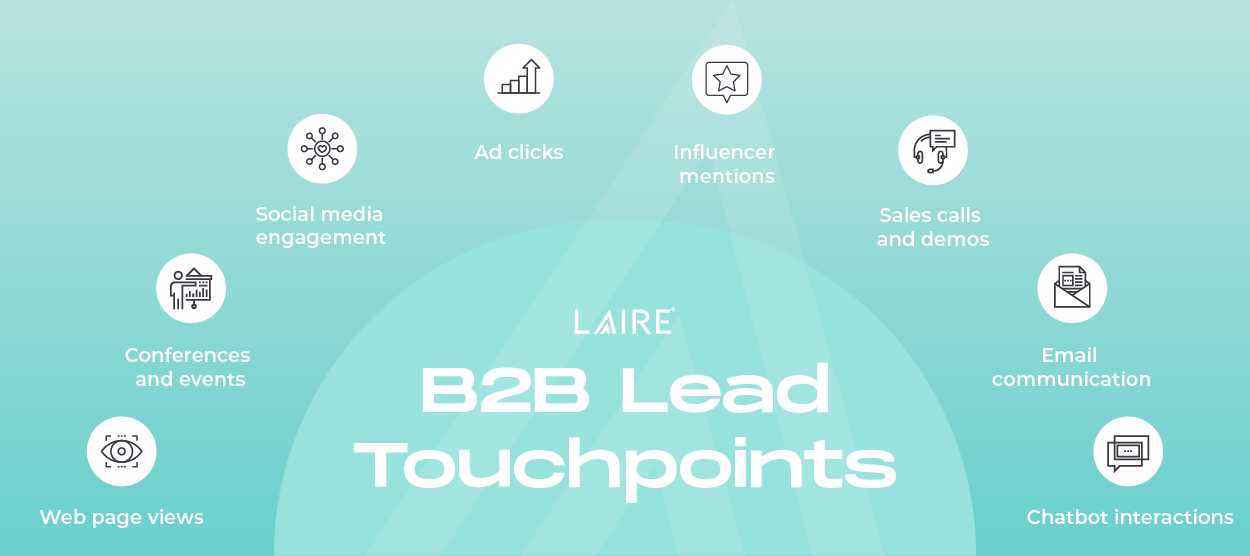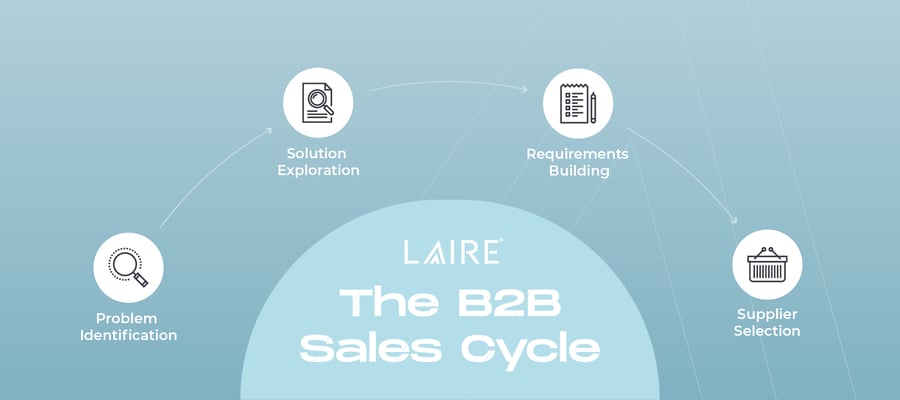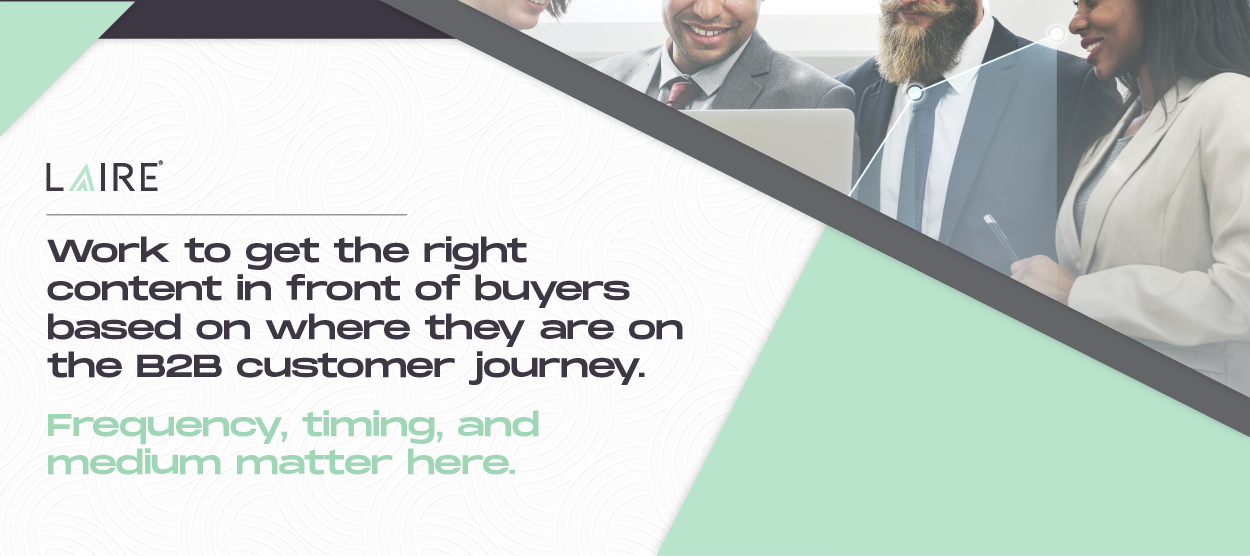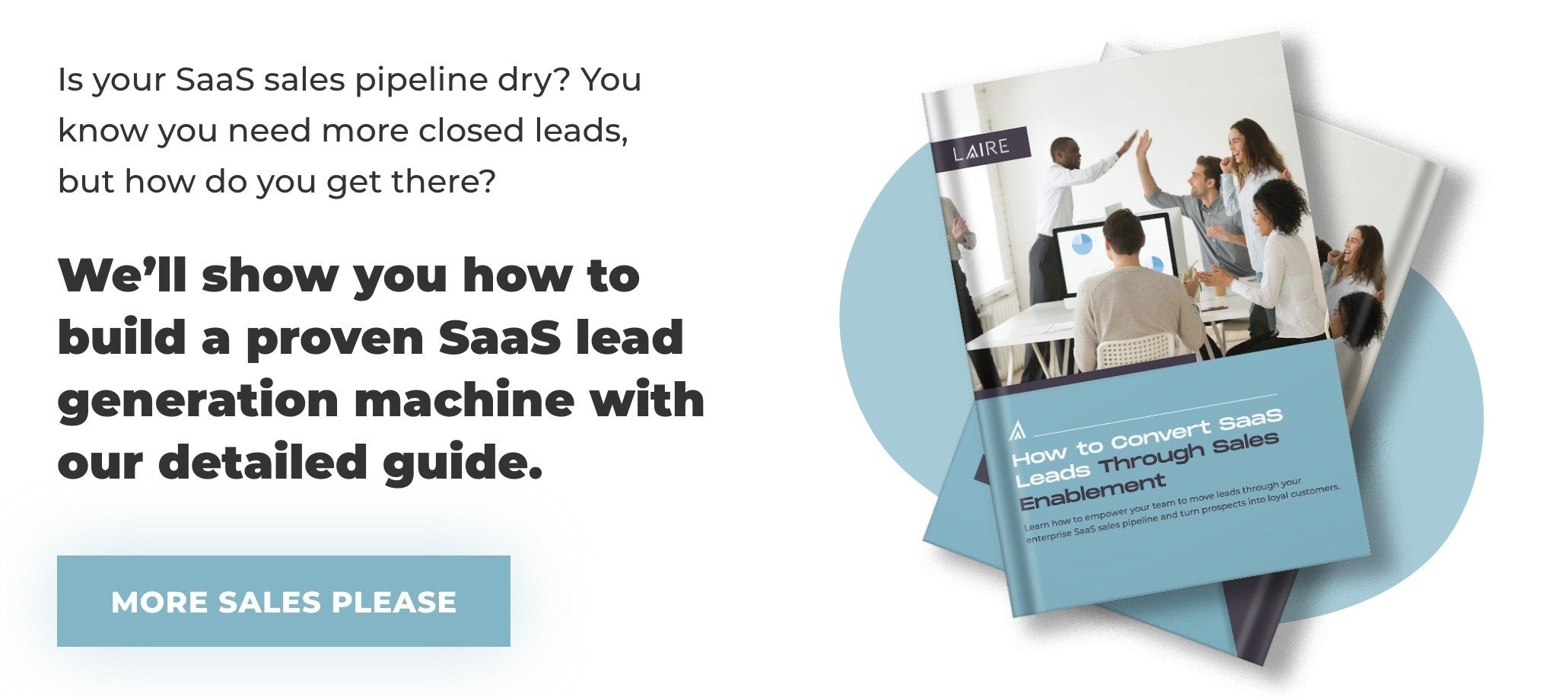TABLE OF CONTENTS
What Are Touchpoints? | The B2B Sales Cycle | Keeping the Customer Journey Moving | Steps in the B2B Customer Journey | FAQs
The journey from initial awareness to acquiring a new customer can be a complex and multifaceted process.
Every buyer will go through a series of touches in a sort of logical order. Some buyers will need more touches than others because it's a buying journey — open-world style, not a single, well-trodden path.
Join us as we unravel the layers of interaction, engagement, and influence that pave the way for meaningful connections, shedding light on the question that every marketer seeks to answer for optimal conversion success.
What Are Marketing B2B Touchpoints?
First things first: What is considered a B2B touchpoint? This refers to the various points of interaction between a business and its potential customers throughout the buyer's journey.
Touchpoints are crucial moments where a business has the opportunity to engage, influence, and build relationships with its target audience. In the B2B context, the buyer's journey is often more complex and involves multiple decision-makers. Marketing touchpoints can include online and offline interactions, such as:
- Ad clicks
- Chatbot interactions
- Conferences and events
- Email communication
- Influencer mentions
- Sales calls and demos
- Social media engagement
- Web page views

Understanding and optimizing these touchpoints is essential for B2B marketers to create a cohesive and effective marketing strategy. By strategically managing and enhancing these interactions, businesses can guide potential customers through the buyer's journey and ultimately increase the likelihood of successful conversions and long-term relationships.
You also have touchpoints after the sale. These are critical to retaining customers and generating social proof that attracts new customers. These B2B customer journey touchpoints include thank you letters, surveys, onboarding, upselling, and continued engagement through social media.
The point is that there are many ways a B2B buyer may touch your brand. And by the time they're contracting, they may have touched your brand over 50 times.
For example, some buyers will follow you on social media and engage with your posts for months before they take the next step. But this doesn't have to be (and shouldn't be) a chaotic process. It can become very repeatable and scalable with predictable revenue growth to show for it.
The goal is to understand how these touchpoints guide a buyer's journey and to get all of them moving in one direction by aligning your content with the B2B customer journey.
Understanding the B2B Sales Cycle

In inbound marketing, we have the buyer's journey: Awareness, Consideration, and Decision.
But a Gartner representation of the B2B customer journey shows just how complex what's happening behind the scenes can be and why keeping your B2B customer journey touchpoints moving in the right direction is so critical. They break it down into:
- Problem Identification (Awareness)
- Solution Exploration (Consideration)
- Requirements Building (The cusp of Consideration and Decision)
- Supplier Selection (Decision)
Problem Identification
Your buyer is doing independent research online. 90% of buyers start their journey the same way you would: They Google it.
Paid and organic (SEO) search marketing is critical here. You need to be visible where your target audience is searching for information about their problems. Your content helps them understand their problem, talks about solutions, and encourages them to learn more about the solution with a download or sign-up for a more in-depth look.
This leads them into the next phase. At the same time, you generate a marketing lead and now have a contact. So far, so good.
Solution Exploration
Most B2B buying decisions involve multiple decision-makers, so several things could happen here. That's why requesting a download or sign-up to collect their contact information for lead nurturing is vital.
Take a look at some example scenarios that may play out during this stage:
- Scenario 1: A prospect reads your whitepaper or attends a webinar, has everything they need to know, and moves to the next phase. They might follow you on social media and read reviews, but they're actively moving forward.
- Scenario 2: Your solutions seem misaligned with their problem, and they go back to Google.
- Scenario 3: They share your content with other decision-makers.
In Scenario 3, additional decision-makers are talking about your brand, following you, and even providing their contact information in return for a valuable offer or piece of content. During this time, you're nurturing these leads with emails, retargeting ads, and social media to keep them engaged in the consideration process.
But you must also provide them with new information. They may need it to make the case to other decision-makers.
Requirements Building
Can your brand provide this buyer with what they need? That's what they’ll figure out in this next phase.
If you're a B2B technology company, prospects are looking at how well your product integrates into their existing tech stack. At this point, they need content like a demo, free trial, case study, virtual walkthrough, buyer's guide, and side-by-side comparisons of different plans, packages, and options. To whatever extent possible, they need to be able to experience the solution.
They're invested now, so they're less likely to back out. But you want to stay on their mind so that this process doesn't take longer than it should. If it gets drawn out, priorities or leadership could change, and they sail back to square one.
Once they receive decision-making content, you follow up with email sequences and sales enablement content that connect them with the face and name of a sales representative ready to help them hash out the final details.
This may be the first time someone is physically talking to them. By now, your goal is to have a very informed buyer ready to move forward.
If the buyer ignores the email sequences or dodges sales calls, send them back to the Solution Exploration phase. It may just not be the right time. In fact, roughly 50% of leads are qualified in every aspect except one: the timing is off.
But it's worth the wait — a nurtured lead spends 47% more than those who buy outright.

This may sound chaotic and counter-productive to someone sales prospecting with an outbound mindset. This is not the linear path you may have envisioned.
However, marketing automation like lead scoring, automated hand-offs, email sequences, and segmented B2B marketing email workflows will make this process seamless for both the buyer and the Marketing and Sales teams.
Keeping the B2B Customer Journey Moving in the Right Direction
First, your website should be designed and optimized to guide buyers through this B2B customer journey regardless of how many B2B customer journey touchpoints they need to get there.
Track website performance. Constantly work to reveal the visitors you can't see because of private browsers or third-party cookie restrictions by enticing them to become a contact through an exchange of value for value — such as a whitepaper or webinar.
Work to get the right content in front of buyers based on where they are on the B2B customer journey. Frequency, timing, and medium matter here.
 Make lead nurturing and sales prospecting as automated as possible to ensure this is streamlined and seamless for the buyer.
Make lead nurturing and sales prospecting as automated as possible to ensure this is streamlined and seamless for the buyer.
Frequency
You want leads to encounter B2B customer journey touchpoints with some frequency so that you stay top of mind, and so they are encouraged to take the next step. But you don't want to communicate too frequently where they become annoyed and block you.
Timing
Timing is about sending the right message at the right time. If they're already in decision-making, you don't want to send them back to an earlier stage. What would this person find most helpful right now? What does their boss need to see to authorize this purchase?
Mediums
We live in a diverse omnichannel world. You can have multiple B2B customer journey touchpoints on one medium, but those touchpoints will most likely be spread across various platforms and channels.
For example, if someone sees your optimized profile on LinkedIn, they will probably check you out on Facebook and review sites. They may visit your website and sign up for your email too.
Each of these and more are part of the B2B customer journey.
The more "mediums" through which you can reach this person, the better chance you have to keep them moving through the B2B sales cycle:
- SEO
- Pay-per-click (PPC) ads
- Social media posts
- Social ads
- Video content
- Webinars
- Your blog
- Website service/product pages
- Chatbots
- Live chat
- Video chat
- App
- Troubleshooting guides
- FAQs
- Buyer's guides
- Owner's manuals
- Whitepapers
- Phone calls
- Self-service buying and upgrading
- Customer success outreach
- Customer-led forums
You may or may not want to tackle all of them. But the truth is that the buyer will be looking for these from your B2B marketing, sales, and service teams.
Mapping Out the B2B Customer Journey
The more data you've already collected about your customer journey, the easier this will be. And if you currently feel your data analytics is lacking, know that's really the first step to understanding this path.
1. Start With a General Outline
One of the simplest ways to look at this is:
- Awareness
- Consideration
- Decision-making
- Onboarding/choosing to stay
2. Define the Touchpoints in Each Stage
This is a little different for each company. We've provided many B2B customer journey touchpoint examples to get you started. But make this your own.
If you just want to focus on one stage of the journey right now, because that's your problem area, put your resources there.
3. Prioritize Touchpoints
We all have to start somewhere. Try to tackle it all at once by yourself, and it will be hard to gain traction. With that said, a B2B marketing agency like LAIRE has a proven system and a team that can help you get your priority touchpoints up and running so you can build on them.
These priorities need to enhance two vital company goals because these two things impact your ability to do anything:
- Increasing revenues: If you're not making money, you won't have any to invest, improve, and grow.
- Delivering a delightful customer experience: If you don't put emphasis here, people will demand refunds, write bad reviews, and take other actions that could cause permanent damage.
4. Establish Best Practices
Describe what you want a customer to experience at your priority touchpoints. Then work your way back. What do you need to do to make sure they have that experience? What barriers must you overcome to make sure that happens?
Develop a list of best practices for that touchpoint from this exercise.
5. Establish B2B Marketing KPIs for Each Touchpoint
Research benchmarks and set key performance indicators (KPIs) using a SMART (Specific, Measurable, Attainable, Relevant, and Time-bound) goal structure.
Measure your results against your KPIs for each touchpoint — test, optimize, and hold yourself accountable for the outcomes.
6. Automate as Many Touchpoints as You Can
Frequency and timing are very automatable. You can also establish triggers to automate the hand-off into the next stage and from marketing to sales and then to service. For example, you can automatically send the appropriate content using the right medium, frequency, and timing to close this deal.
7. Scale It
Continue to test, refine, rinse, repeat, and scale this process to grow your business.
FAQs About B2B Marketing Touchpoints
How many touchpoints does it really take to close a B2B customer?
There’s no single number that fits every business, but research and experience show that B2B buyers often engage with 20 to 50+ touchpoints before making a purchase decision. The actual number depends on the product’s complexity, deal size, and how many decision-makers are involved.
The key is to make every touchpoint intentional, connected, and aligned with the buyer’s journey.
Why are B2B customer journeys so much longer than B2C?
B2B purchases typically involve multiple stakeholders, longer evaluation periods, and higher investment levels. Buyers need to research, compare, and justify decisions internally, which naturally creates more touchpoints. Each interaction must build trust and help move the buyer closer to confidence in your solution.
Can the buyer’s journey be shortened?
Yes, when your content strategy, website, and automation work in sync. By offering clear, helpful information at each stage and removing friction (like difficult forms or unclear pricing), you can shorten the research phase and accelerate conversions. Personalization and retargeting also help keep your brand top of mind without overwhelming prospects.
How can marketing automation improve touchpoints?
Marketing automation ensures every interaction feels personalized, timely, and relevant. It helps nurture leads automatically with the right content at the right time and triggers next steps based on behavior. This keeps your funnel flowing efficiently while freeing your team from repetitive tasks.
How can AI improve the effectiveness of B2B marketing touchpoints?
AI helps make every touchpoint smarter and more personalized. By analyzing customer data and behavior patterns, AI can predict what a buyer needs next, from suggesting relevant content to triggering timely follow-ups. This ensures that each interaction adds value, builds trust, and moves the buyer closer to conversion.
What role do large language models (LLMs) play in managing customer interactions?
LLMs like ChatGPT or HubSpot’s AI Copilot can engage prospects in natural, conversational ways across multiple touchpoints, from chatbots and email responses to personalized website recommendations. These models help answer complex questions instantly, summarize data, and provide tailored insights that feel human, not robotic.
How do AI-driven insights help personalize the buyer journey?
AI uses behavioral and contextual data, like browsing history, search intent, or CRM interactions, to deliver hyper-personalized experiences. This could mean recommending the next best piece of content, optimizing email timing, or dynamically updating website messaging to match the user’s industry or interests.
The Easiest Way to Streamline B2B Customer Journey Touchpoints
We'd love to give you a clear-cut answer to the question, “How many touchpoints does it take to close a new B2B customer?” But the B2B customer journey is just not that straightforward.
That said, it doesn’t have to be complicated or inefficient. You can design a well-oiled machine through the proper use of marketing automation and inbound marketing strategy.


